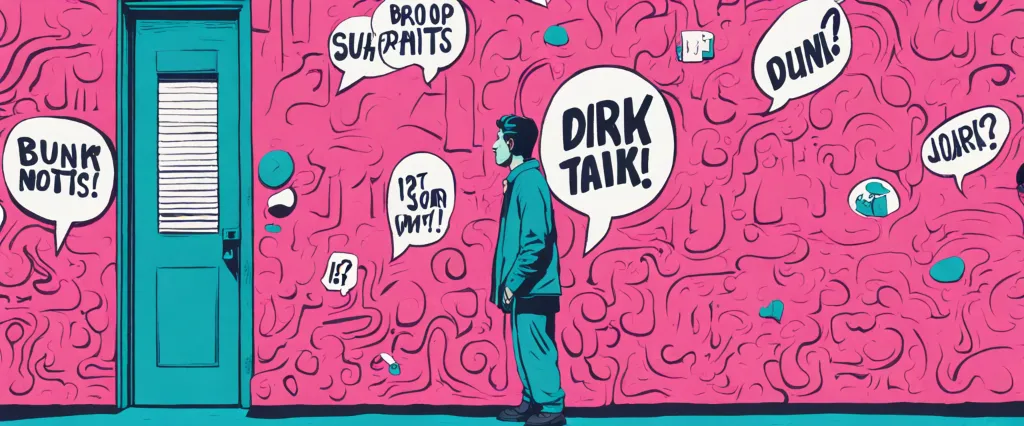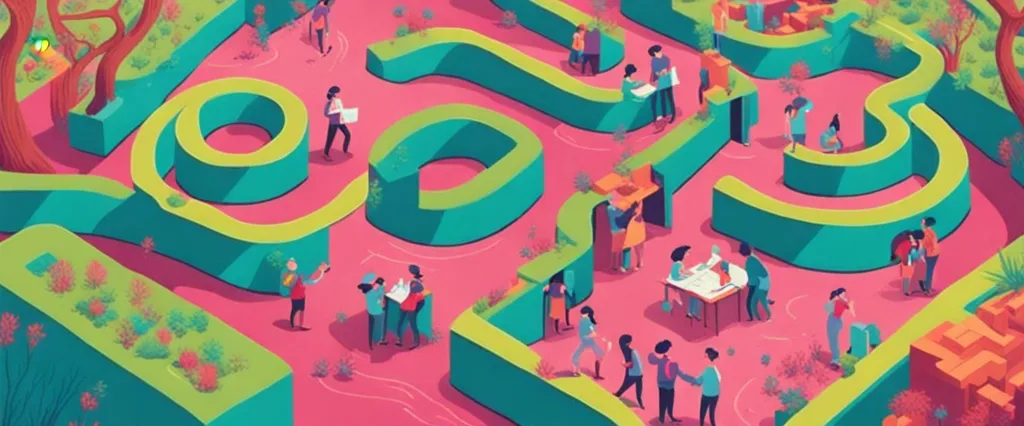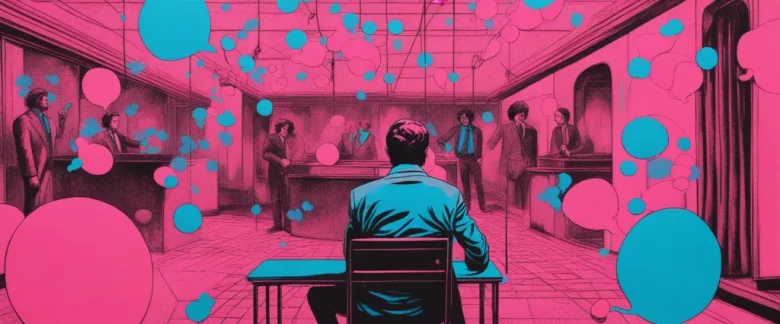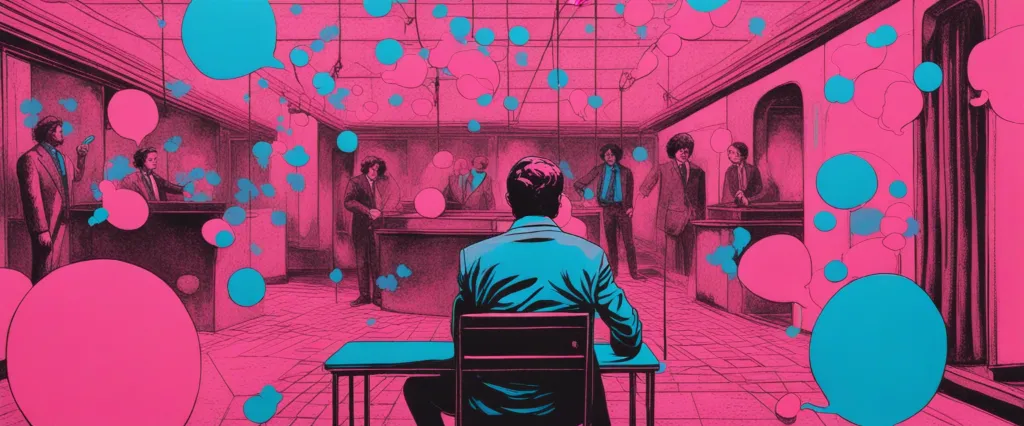In his thought-provoking book “Drunk Tank Pink,” author Adam Alter delves deep into how the environment surrounding us influences our thoughts, emotions, and actions. Drawing upon an array of captivating research findings, Alter sheds light on the fascinating ways in which subtle cues in our surroundings impact our daily lives. As an esteemed professor of marketing and psychology at New York University, Alter possesses a unique expertise in understanding the intricate relationship between our environment and our behavior. With an insightful exploration of this overlooked phenomenon, Alter challenges conventional assumptions while providing valuable insights into the hidden forces that shape our perceptions and choices.
Chapter 1: The Power of Color: Unveiling the Influence of Drunk Tank Pink
Chapter 1 of the book “Drunk Tank Pink” by Adam Alter explores the concept of how color, specifically the color pink, can have a powerful influence on human behavior and perception. The chapter begins by introducing the reader to a famous experiment conducted by Alexander Schauss in the 1970s, which involved painting the walls of a prison cell in a shade of pink called “drunk tank pink.” This color was found to have a calming effect on the inmates, leading to a reduction in violent behavior and an overall improvement in their mental state.
Alter delves deeper into the psychological and physiological factors that contribute to the influence of color. He explains that color has the ability to evoke emotional responses and can impact cognitive processes such as attention, memory, and decision-making. The author discusses various experiments and studies that demonstrate the effects of color on human behavior. For instance, he highlights research that suggests the color red can increase aggression, blue can enhance creativity, and green can improve focus and productivity.
In addition to exploring the impact of color on individuals, Alter also discusses the role of color in social and cultural contexts. He explains how companies and marketers utilize color to create brand identities and influence consumer behavior. Furthermore, the chapter raises interesting questions about the universality of color perception and whether cultural differences can alter the effects of color on individuals.
Overall, Chapter 1 of “Drunk Tank Pink” sets the foundation for the book’s exploration of the power of color by providing fascinating insights into how color influences human behavior, from its psychological and physiological effects to its societal and cultural implications.
Chapter 2: Perception and Behavior: How Colors Shape Our Actions
Chapter 2 of “Drunk Tank Pink” by Adam Alter explores the impact that colors have on our perception and behavior. The chapter delves into various experiments and studies that demonstrate how colors can shape our actions and influence our emotional and cognitive processes.
Alter begins by discussing the color pink and its calming effects, drawing attention to the “drunk tank pink” phenomenon, which refers to the use of pink-colored rooms in prisons to reduce aggressive behavior in inmates. He explains that exposure to this color has been found to lower heart rate, decrease aggression, and even suppress hunger.
The author then shifts focus to the color red, highlighting studies that reveal its ability to evoke strong emotional responses. Red has been shown to increase the perception of dominance and intensify physical reactions, such as heart rate and blood pressure. It is also associated with increased attractiveness in the eyes of both men and women.
Alter also discusses the impact of other colors, such as blue and yellow. Blue has a calming effect and is often used in offices as it enhances productivity and focus. On the other hand, yellow is associated with increased arousal and heightened attention, making it a popular color choice for warning signs and advertisements.
Through these examples, Alter emphasizes the unconscious impact that colors can have on our behavior and decision-making. Understanding these effects can be useful in a variety of contexts, including marketing, interior design, and even personal well-being. Recognizing the power of colors allows individuals and organizations to harness this knowledge to shape behavior and create desired outcomes.
Chapter 3: The Psychology of Persuasion: Harnessing Color to Influence Others
Chapter 3 of “Drunk Tank Pink” by Adam Alter delves into the psychology of persuasion, specifically focusing on the influence of color. The chapter explores how colors can be harnessed to manipulate emotions and behavior, shedding light on the role colors play in our everyday lives.
Alter begins by discussing the interplay between color and emotion. He explains how certain colors can evoke specific feelings and impact our mood or behavior. For example, warm colors like red and yellow are often associated with energy and excitement, while cool colors like blue and green evoke calmness and relaxation. By leveraging these color-emotion associations, individuals can influence people’s reactions and decisions.
The author goes on to examine various real-life examples of color persuasion. He explains how advertisers and marketers strategically use color in their branding and packaging to entice consumers. Alter highlights how the color red is often employed to create a sense of urgency and promote quick decision-making, such as in clearance sales or limited-time offers. Similarly, the chapter discusses how restaurants use specific color schemes to influence diners’ appetite and food preferences.
Additionally, the chapter explores the impact of color in other domains, such as sports and prisons. Alter discusses how sports teams often benefit from the psychological effects of color, with certain colors stimulating performance and intimidating opponents. He also explores the phenomenon known as “drunk tank pink” – a particular shade of pink used in prisons to help calm aggressive behavior.
Overall, Chapter 3 of “Drunk Tank Pink” delves into the fascinating ways in which colors can be harnessed to influence our emotions, behavior, and decision-making processes. By understanding the psychology of color persuasion, individuals can become more aware of its effects and potentially harness this knowledge to their advantage.
Chapter 4: The Impact of Environment: Exploring Color’s Effects on Mood and Performance

Chapter 4 of “Drunk Tank Pink” by Adam Alter explores the impact of environment, specifically the effect of color on mood and performance. The chapter delves into how different colors can evoke various emotions and influence human behavior.
Alter begins by recounting the story of a painter exposed to the color pink who experienced decreased aggression and the calming effect it had on inmates in a holding cell. This leads him to discuss the concept of “pink goggles” — the belief that viewing the color pink leads to decreased performance and aggression.
The author then delves into various studies and experiments that highlight the different effects of colors on mood and behavior. Alter reveals that blue can enhance creativity and focus, while red can promote physical performance and increase attention to detail. Additionally, he uncovers a study that suggests that exposure to green environments can reduce ADHD symptoms in children.
Alter also explores the cultural and geographical differences in color perceptions and how different industries utilize color psychology to influence consumer behavior. For example, fast-food restaurants often use red and yellow to increase appetite and stimulate quick eating, while many hospitals opt for soothing blues and greens to promote calmness and healing.
Overall, Chapter 4 of “Drunk Tank Pink” sheds light on how colors can impact mood and performance in various contexts. It demonstrates the power of color as a tool for manipulation and how understanding these effects can help individuals make informed decisions regarding their environment and the colors they surround themselves with.
Chapter 5: Branding and Marketing: Leveraging Color to Capture Attention
Chapter 5 of “Drunk Tank Pink” by Adam Alter explores the profound impact of color in branding and marketing strategies, emphasizing how colors can effectively capture attention and influence consumer behavior. Alter highlights several key findings and examples to support his argument.
The chapter begins by discussing the color red and its ability to enhance human performance and increase levels of aggression. Alter presents studies showing that sports teams wearing red tend to win more often and that the color red can even boost physical performance in athletes. Furthermore, he mentions how companies like McDonald’s and Coca-Cola intentionally use red in their branding to evoke excitement and urgency within customers.
Alter then shifts focus to the color blue, which has been found to have a calming and tranquilizing effect. He provides examples of brands such as Facebook and Twitter, which use varying shades of blue in their logos and interfaces to create a sense of trust and reliability.
Another compelling point examined is the use of color in gender-based marketing. Alter describes how marketers heavily rely on gender stereotypes, such as using pink for girls and blue for boys, to target specific demographics. He underscores that these color associations are not inherent, but rather socially constructed over time.
Additionally, Alter delves into the psychological implications of color, mentioning that warm colors like orange and yellow can increase appetite and induce impulse buying, while cooler colors like green and purple are associated with wealth and luxury.
In summary, Chapter 5 of “Drunk Tank Pink” elucidates the power of color in branding and marketing. By leveraging hues that align with desired emotions and behaviors, companies and marketers can effectively capture attention, stimulate purchasing decisions, and even influence performance.
Chapter 6: The Dark Side of Color: Uncovering Manipulation and Deception
Chapter 6 of “Drunk Tank Pink” by Adam Alter focuses on the dark side of color, exploring how it can be used to manipulate and deceive individuals. The chapter begins by discussing the concept of subliminal messaging, where advertisers use colors to subtly influence consumers’ decisions without their conscious awareness.
One example discussed is the use of red in casinos, which is strategically employed to enhance excitement and encourage risk-taking behavior. By evoking strong emotions of anger and passion, red can prompt individuals to make impulsive choices that benefit the casino. Another example is the color pink, which has been used to pacify aggressive individuals in drunk tanks and prison cells. It has been suggested that exposure to pink can reduce aggression and even physical strength, leading to more cooperative behavior.
Alter also examines how color can be misrepresented to deceive consumers. For instance, food companies often employ artificial additives to manipulate the appearance of products. Blue is added to make food appear less ripe, while yellow is used to simulate buttery richness. The chapter highlights how these color deceptions can lead to false assumptions about the quality or nutritional value of a product.
Additionally, the chapter explores the phenomenon of “brand-specific colors” and how they shape our perception and preference for certain products. Companies spend significant resources selecting and trademarking specific colors to create distinct identities. By associating colors with characteristics or emotions, brands can shape consumer perception and loyalty.
In summary, Chapter 6 uncovers the darker side of color manipulation and deception. Through the use of subliminal messaging, misleading food colorings, and brand-specific colors, individuals can be influenced and deceived without their conscious awareness of these tactics. The chapter sheds light on the power of color and its impact on human behavior and decision-making processes.
Chapter 7: Color in Everyday Life: From Home to Workplace
Chapter 7 of “Drunk Tank Pink” by Adam Alter explores the influence of color in our everyday lives, from our homes to the workplace. The author delves into the psychology behind color perception and its impact on our behaviors and emotions.
Alter begins by discussing how colors affect our moods and decisions in our homes. He explains that warm colors like red and orange can stimulate appetite and conversation, making them popular choices for dining rooms and kitchens. Cool colors like blue and green, on the other hand, promote relaxation and tranquility, leading people to choose them for bedrooms and bathrooms.
Moving on to the workplace, Alter highlights the effects of color on productivity and creativity. He explains that blue is often associated with productivity and focus, making it a common color in offices. However, he notes that overly blue environments can lead to a decrease in motivation and creativity. On the other hand, incorporating small pops of vibrant colors, like red or yellow, can stimulate energy and enhance productivity.
The author also delves into the influence of color on branding and marketing. He asserts that colors play a significant role in shaping consumers’ perceptions and decisions. For example, red is often associated with excitement and urgency, leading companies like Coca-Cola to utilize it to capture attention. Similarly, green can evoke feelings of trust and eco-friendliness, making it a popular color for environmentally conscious brands.
In summary, Chapter 7 of “Drunk Tank Pink” explores the impact of color on our homes, workplaces, and consumer behavior. It highlights how various colors can influence our moods, productivity, and decision-making processes. Understanding the psychology of color can help individuals and businesses create environments that effectively support their goals and desires.

Chapter 8: Designing with Intention: Applying Color Psychology for Positive Change
Chapter 8 of the book “Drunk Tank Pink” by Adam Alter explores the concept of color psychology and its application in design to bring about positive changes. The author discusses how colors can have a significant impact on our emotions, behavior, and decision-making processes.
The chapter begins by highlighting the power of red as a color associated with alarm or danger. Research suggests that exposure to the color red can increase heart rate and evoke a sense of urgency, thereby affecting our behavior. Alter also explores the effects of other colors like blue, green, and yellow, which have calming, soothing, and inspiring properties respectively.
The author delves into the influence of color in various settings, starting with the workplace. He explains how brighter colors in office spaces can increase productivity and creativity, while blue tones can promote a sense of trust and efficiency. Additionally, Alter explores the use of color in marketing and advertising. For instance, yellow is often employed in food packaging as it stimulates appetite, while green is associated with health and well-being.
Furthermore, the author emphasizes the importance of considering cultural differences in color associations. Different cultures interpret colors in various ways, so understanding local preferences is crucial when designing for specific populations.
Towards the end, the chapter presents examples of how color psychology has been applied successfully. For instance, blue streetlights have been used in some cities to reduce crime rates, as the light makes people appear more pallid and suspicious. Overall, this chapter demonstrates how understanding the psychology of color can lead to intentional and positive design choices that impact human perception, behavior, and experiences in various domains of life.
After Reading
In conclusion, “Drunk Tank Pink” by Adam Alter offers a fascinating exploration of how environmental factors influence our thoughts, feelings, and behaviors. From the impact of colors on our mood to the subtle cues that shape our decisions, Alter highlights the powerful ways in which our surroundings shape our lives. By understanding these influences, readers can become more aware of the factors that contribute to their behavior and make conscious choices to create environments that support their goals. Overall, “Drunk Tank Pink” provides valuable insights into the often unseen forces that shape our everyday experiences.
1. The Power of Habit: Why We Do What We Do in Life and Business” by Charles Duhigg – Similar to “Drunk Tank Pink,” this book explores the fascinating world of human behavior and how our habits shape our lives. Duhigg delves into the science behind habits, explaining how they are formed, changed, and the immense influence they have on our daily routines.
2. Influence: The Psychology of Persuasion” by Robert Cialdini – This book delves into the psychology of persuasion and examines the various tactics people use to influence others. Drawing on decades of research, Cialdini reveals the principles behind why we say “yes” to certain requests and how to defend ourselves against manipulation.
3. Thinking, Fast and Slow” by Daniel Kahneman – Kahneman, a Nobel laureate, explores the two systems of thinking that govern our decisions – the intuitive and impulsive “fast” system and the more reflective and deliberate “slow” system. This book examines the biases and heuristics that affect our judgment and provides valuable insights into how we can make better choices.
4. Predictably Irrational: The Hidden Forces That Shape Our Decisions” by Dan Ariely – In a similar vein as “Drunk Tank Pink,” Ariely reveals how our decisions are often influenced by illogical and irrational factors. Using engaging examples and experiments, he exposes the hidden forces that affect our choices and sheds light on why we often act against our best interests.
5. “Sway: The Irresistible Pull of Irrational Behavior” by Ori Brafman and Rom Brafman – This book explores the irrational behavior that influences our decision-making, often leading to unintended consequences. The authors dive into various psychological phenomena and social dynamics, offering an insightful look into why we sometimes make irrational choices and how to avoid falling into the sway of our emotions.




